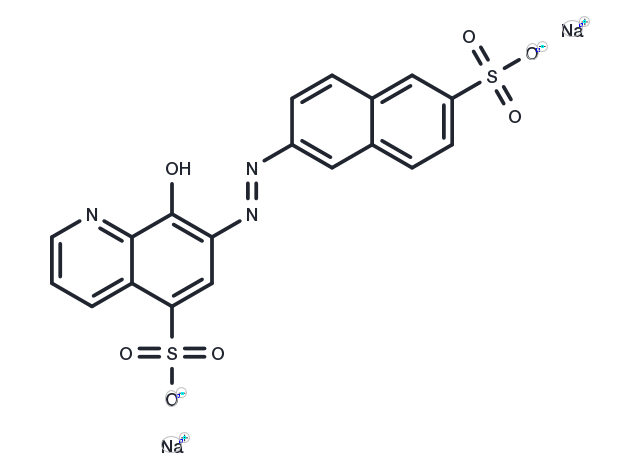Powder: -20°C for 3 years | In solvent: -80°C for 1 year


NSC-87877 disodium (NSC87877) is a cell-permeable inhibitor of both SHP-1 and SHP-2 with IC50 values of 355 and 318 nM respectively. It also inhibits EGF-induced Erk1/2 activation in HEK293 cells and significantly reduces MDA-MB-468 cell viability/proliferation.

| Pack Size | Availability | Price/USD | Quantity |
|---|---|---|---|
| 5 mg | In stock | $ 65.00 | |
| 10 mg | In stock | $ 94.00 | |
| 25 mg | In stock | $ 195.00 | |
| 50 mg | In stock | $ 326.00 | |
| 100 mg | In stock | $ 486.00 | |
| 200 mg | In stock | $ 695.00 | |
| 1 mL * 10 mM (in DMSO) | In stock | $ 83.00 |


| Description | NSC-87877 disodium (NSC87877) is a cell-permeable inhibitor of both SHP-1 and SHP-2 with IC50 values of 355 and 318 nM respectively. It also inhibits EGF-induced Erk1/2 activation in HEK293 cells and significantly reduces MDA-MB-468 cell viability/proliferation. |
| Targets&IC50 | SHP2:318 nM, SHP1:355 nM |
| In vitro | NSC-87877 seems to have no selectivity between human Shp2 and Shp1 in vitro. NSC-87877 inhibits EGF-stimulated Shp2 activation and EGF-induced Erk1/2 activation. NSC-87877 suppresses Erk1/2 activation by a Gab1-Shp2 chimera but does not affect PMA(phorbol 12-myristate 13-acetate)-induced Erk1/2 Activation. NSC-87877 does not inhibit EGF-induced Gab1 tyrosine phosphorylation and Gab1-Shp2 association. NSC-87877 can significantly reduce MDA-MB-468 cell viability/proliferation, especially in combination with a phosphoinositide 3-kinase inhibitor[1]. |
| In vivo | NSC-87877 almost completely prevented EAE(experimental autoimmune encephalomyelitis) development by blocking the accumulation of inflammatory cells in the CNS(central nervous system)[2]. In an intrarenal mouse model of neuroblastoma, NSC-87877 treatment results in decreased tumor growth and increased p53 and p38 activity[3]. Intrathecal administration of NSC-87877 (an SHP2 antagonist; 1, 10, or 100 μM/rat) into the allodynic rats suppresses spinal nerve ligation-induced allodynia, spinal SHP2 and NR2B phosphorylation, and SHP2/phosphorylated SHP2-PSD-95 and PSD-95-NR2B/phosphorylated NR2B coprecipitation[4]. |
| Cell Research | Serum-starved cells are pretreated with NSC-87877 (50 μM,3 h) or dimethyl sulfoxide (solvent) and then stimulated with EGF (100 ng/ml, 5 min) or left untreated. Cells are lysed in ice-cold PTP(protein tyrosine phosphatase) lysis buffer. Shp2 or Shp1 in cell lysate supernatants (0.5 mg/each) is immunoprecipitated with an antibody to Shp2 or an antibody to Shp1 plus protein A-Sepharose for 2 h at 4°C. (Only for Reference) |
| Synonyms | NSC87877 |
| Molecular Weight | 503.42 |
| Formula | C19H13N3O7S2·2Na |
| CAS No. | 56932-43-5 |
Powder: -20°C for 3 years | In solvent: -80°C for 1 year
Ethanol: < 1 mg/mL (insoluble or slightly soluble)
DMSO: 93 mg/mL (184.7 mM)
H2O: 92 mg/mL (182.7 mM)
You can also refer to dose conversion for different animals. More
bottom
Please see Inhibitor Handling Instructions for more frequently ask questions. Topics include: how to prepare stock solutions, how to store products, and cautions on cell-based assays & animal experiments, etc.
NSC-87877 disodium 56932-43-5 Apoptosis Metabolism Phosphatase Neuroblastoma inhibit NSC 87877 Inhibitor NSC 87877 disodium PPAR p53 NSC-87877 HSP27 NSC87877 disodium NSC87877 p38 inhibitor
